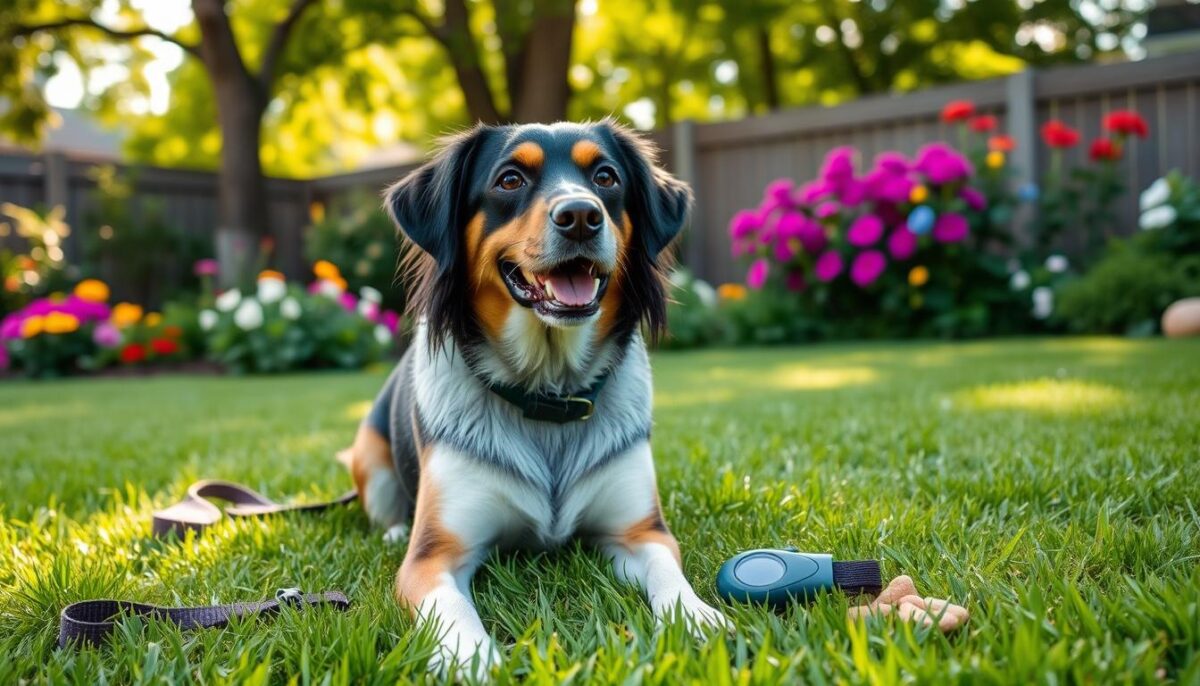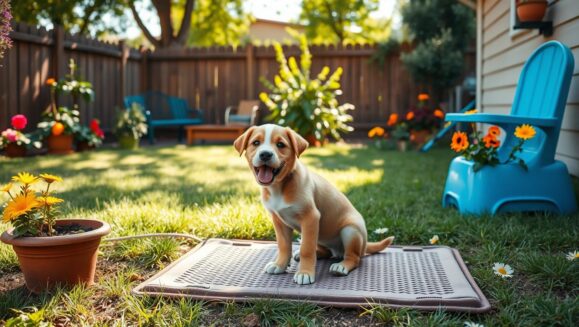Did you know adult dogs can hold their bladder for up to 10 hours? This fact shows how important potty training is for all dogs. Whether you have a puppy or an adult dog, teaching them to control their bladder is critical for a happy home.
Potty training isn’t just for puppies. Many adult dogs need training again because of stress, health issues, or not learning early on. Small dogs often find it hard to stay clean indoors. Knowing these challenges helps in training them well.
Being consistent and patient is crucial for potty training. Puppies get better with age, with a rule of one hour of control per month. Adult dogs do well with crate training, as it uses their instinct to keep their area clean.
Medical problems can make house training harder. Issues like urinary tract infections, kidney disease, and diabetes can cause accidents. If your dog’s bathroom habits change suddenly, see a vet to check for health problems.
Key Takeaways
- Adult dogs can hold their bladder for up to 10 hours
- Potty training applies to both puppies and adult dogs
- Small breed dogs may need extra attention in house training
- Medical issues can affect bladder control
- Consistency and patience are essential for successful training
- Crate training can be effective for adult dogs
- Puppies need more frequent bathroom breaks based on their age
Understanding Your Dog’s Natural Bladder Control

Dogs have different bladder control abilities. These vary based on several factors. I’ll explain the main points that affect a dog’s bladder control. This will help you potty train your dog effectively.
Age-Related Bladder Capacity
Puppy bladder control gets better with age. A simple rule is one hour per month of age, plus an extra hour. For example, a two-month-old puppy can hold it for about three hours.
Adult dogs usually can hold it for eight hours. But, each dog is different.
Breed-Specific Considerations
Dog breeds vary in size, which affects their bladder capacity. Larger breeds often have bigger bladders. This means they can hold it longer between bathroom breaks.
Smaller breeds might need to go outside more often.
Physical and Physiological Limitations
Health issues can affect a dog’s bladder control. Problems like urinary tract infections or kidney issues can cause frequent urination. Regular vet visits are important to catch these early.
Some dogs might leak after spay or neuter surgery.
| Age | Bladder Hold Time | Feeding Schedule |
|---|---|---|
| 2 months | 3 hours | 3 times daily |
| 4 months | 5 hours | 3 times daily |
| Adult | 8 hours | 2 times daily |
Knowing these factors helps create a good training plan. Remember, being consistent is crucial for developing good habits. Adjust your training based on your dog’s unique needs for successful bladder control training.
Signs Your Dog Needs Immediate Bathroom Break

It’s important to know when your dog needs to go outside. Dogs can’t talk, but they show signs when they need to go. As a pet owner, I’ve learned to recognize these signs to avoid accidents and keep them on track with potty training.
When your dog suddenly stops playing or walks away, it’s a sign they need to go. Whining or barking can also mean they need a potty break.
Intense sniffing on the ground is another sign. Your dog might circle around before squatting. This is because they’re looking for the right spot. Watch for these signs, especially after naps or meals, when they usually need to go.
| Time | Dog Behavior | Action Needed |
|---|---|---|
| After waking up | Restlessness, whining | Immediate outdoor break |
| 20-30 minutes post-meal | Pacing, sniffing | Take outside promptly |
| During playtime | Sudden inactivity | Pause play for potty break |
Puppies can’t hold it as long as adult dogs. A 3-month-old puppy can hold it for about 3 hours. Adult dogs can wait 6-8 hours, but it’s best not to wait too long to avoid accidents.
Creating an Effective Bathroom Schedule

Setting up a potty schedule is instrumental to training your dog’s bladder control. A well-planned routine helps your pup learn when to expect bathroom breaks. This reduces accidents and promotes better habits.
Morning Routine Optimization
Start your day with a consistent wake-up time. Take your dog out immediately after they wake up. Puppies need more frequent trips, while adult dogs can hold it longer.
Aim for a morning walk that combines exercise with potty time.
Daytime Schedule Planning
During the day, plan regular potty breaks based on your dog’s age and needs. Young puppies require trips every two hours, while older dogs can wait longer. Establish consistent timing for these breaks to reinforce the routine.
| Age | Maximum Time Between Breaks |
|---|---|
| 8-12 weeks | 3 hours |
| 12-16 weeks | 4 hours |
| 16-20 weeks | 5 hours |
| 20+ weeks | 6 hours |
| Adult dogs | 6-8 hours |
Evening Routine Adjustments
As the day winds down, adjust your dog’s schedule. Offer a final potty break before bedtime. Limit water intake in the evening to prevent overnight accidents.
Remember, routine establishment takes time. But with patience and consistent timing, your dog will adapt to the new potty schedule.
Step-by-Step Guide to Train Your Dog to Hold Bladder Longer

Training your dog to hold their bladder longer needs patience and consistency. This guide will help you teach your furry friend to control their bladder better.
Establishing a routine
Make a schedule for meals, potty breaks, and playtime. Feed puppies four times a day to help them go at regular times. Take your pup out every 30 minutes when you’re home and awake. Do this after meals, naps, and play.
Gradually increasing time between potty breaks
Begin with short breaks and gradually make them longer. Puppies can hold their bladder for as many hours as they are months old. Small breeds might need more breaks than big ones.
Using positive reinforcement techniques
Praise and reward your dog for going outside correctly. Give treats, walks, or playtime as rewards. This positive approach helps your dog learn to control their bladder better.
Addressing accidents during training
Stay calm if accidents happen. Clean up well to avoid smells that might cause more accidents. Never punish your dog for mistakes. Instead, praise them for good behavior and keep training consistent.
Remember, training your dog to go in the house can take 4-6 months or more. It depends on your dog’s age and breed. Stay patient and keep trying for the best results.
Establishing a routine

A consistent schedule is vital to successful potty training. I start by creating a daily routine for feeding, playtime, and potty breaks. This helps dogs predict when they’ll have opportunities to relieve themselves, reducing anxiety and improving training success.
Puppies typically need potty breaks every 30 minutes to an hour when not crated. I take them out first thing in the morning, after meals, and before bedtime. For adult dogs, I establish a strict routine with longer intervals between breaks.
Here’s a sample potty training schedule:
- 6:00 AM: Wake up and immediate potty break
- 7:00 AM: Breakfast followed by potty break
- 12:00 PM: Lunch and potty break
- 3:00 PM: Afternoon potty break
- 6:00 PM: Dinner and potty break
- 9:00 PM: Final potty break before bed
I adjust this schedule based on the dog’s age and size. Smaller breeds need more frequent breaks. Puppies can hold their bladder for about one hour per month of age, plus an additional hour.
Consistency in potty training habits is crucial. I use a specific word or phrase as a command for elimination, reinforcing it with positive rewards. This approach strengthens the bond between the dog and owner, making house training more effective.
Gradually increasing time between potty breaks
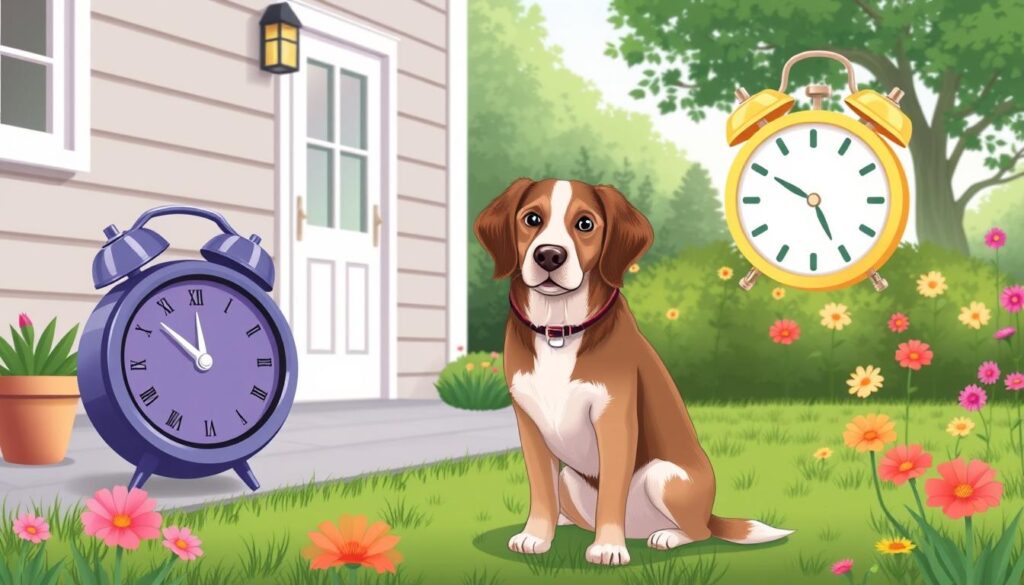
Bladder training needs patience and consistency. I start with frequent potty breaks and slowly extend the intervals. For puppies, I use the age-based rule: one hour per month of age, plus one. This means a 4-month-old pup can hold it for about 5 hours max.
To begin extending potty intervals, I set a timer. I take the dog out every hour at first. Then I increase by 15 minutes each day. I watch closely for signs of discomfort. If the dog struggles, I back off a bit. The goal is gradual progress in controlled elimination.
I keep a log to track success. This helps me spot patterns and adjust as needed. Remember, each dog is unique. Some may progress faster than others in bladder training. Patience is key.
| Week | Potty Break Interval | Success Rate |
|---|---|---|
| 1 | Every hour | 80% |
| 2 | Every 1.25 hours | 85% |
| 3 | Every 1.5 hours | 90% |
| 4 | Every 1.75 hours | 95% |
This gradual approach helps prevent accidents and reduces stress. It’s a critical part of effective bladder training. By slowly increasing the time between breaks, I teach the dog to hold it longer, promoting better bladder control.
Using positive reinforcement techniques
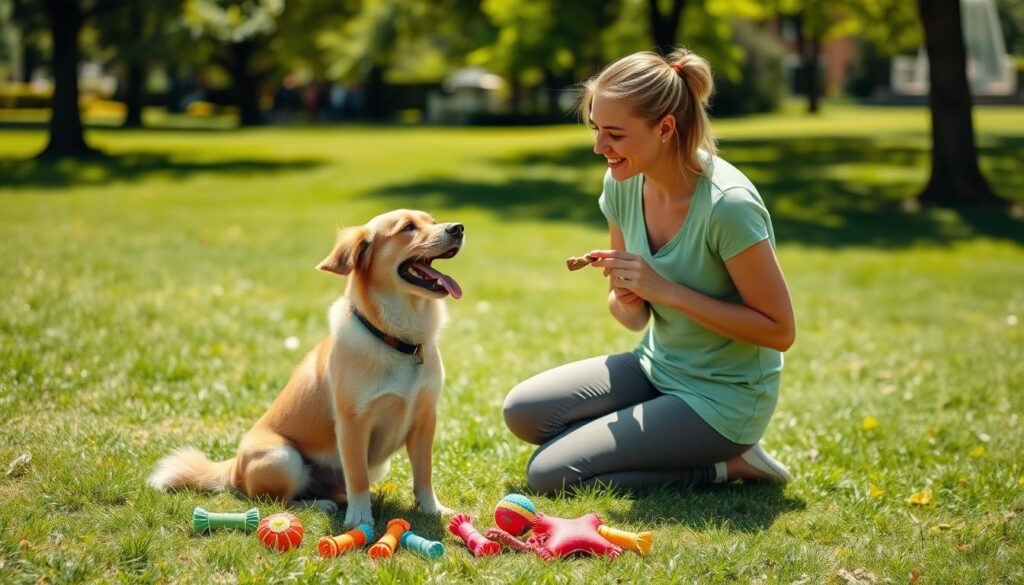
Reward-based training is essential for teaching your dog to hold their bladder longer. I praise good behavior and give treats for potty success. When my pup goes outside, I give them a treat and lots of praise.
This positive action makes them want to do it again. To improve training, I use a specific word or phrase when they go. This helps them connect the command with the action.
I keep treats hidden until the right time to avoid distracting them. Making potty breaks fun and rewarding helps reinforce the behavior I want.
Studies show that most puppies can be house trained in 7 to 14 days with consistent reward-based training. But remember, every dog is unique. Some might take up to six months to learn to use the same spot every time.
- Use a specific word or phrase when your dog eliminates
- Keep treats hidden until the right moment
- Make potty breaks positive and exciting
- Be patient and consistent in your training approach
Don’t expect quick results, as it can stress your puppy. Instead, focus on creating a positive learning environment. With time and consistency, your dog will learn to hold their bladder longer, making life easier for both of you.
Addressing accidents during training
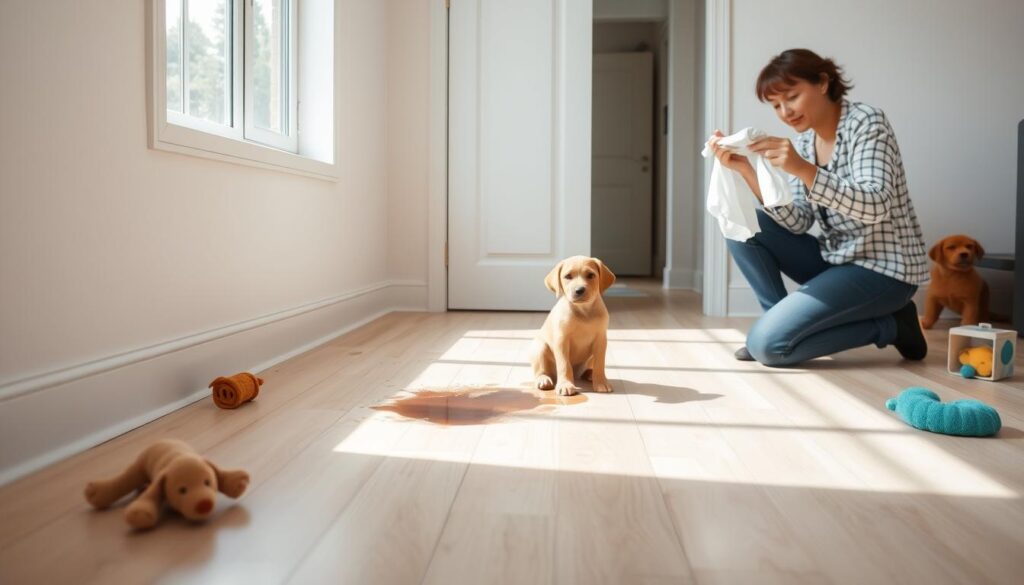
Accidents are a normal part of potty training. Quick cleanup is essential for success. I use enzymatic cleaners to remove all odors.
This stops future accidents in the same spot. It’s important to interrupt mistakes calmly. If I catch my dog in the act, I take them outside.
This teaches them the right place to go. Punishment can make them anxious and slow down progress.
Redirecting them to the right spot works well. I take my dog to their potty area right after an accident. This helps them learn the correct behavior.
If accidents keep happening, I increase potty breaks and watch them closely. Keeping a potty journal helps me track progress. It shows when accidents happen and where.
This helps me adjust my training. It can take up to a year for a dog to be reliably housetrained. For older puppies who start having accidents again, I treat it like training a new puppy.
I give them more bathroom breaks and reward them when they go outside correctly. Being consistent is crucial in retraining them.
Establishing a Consistent Feeding Pattern
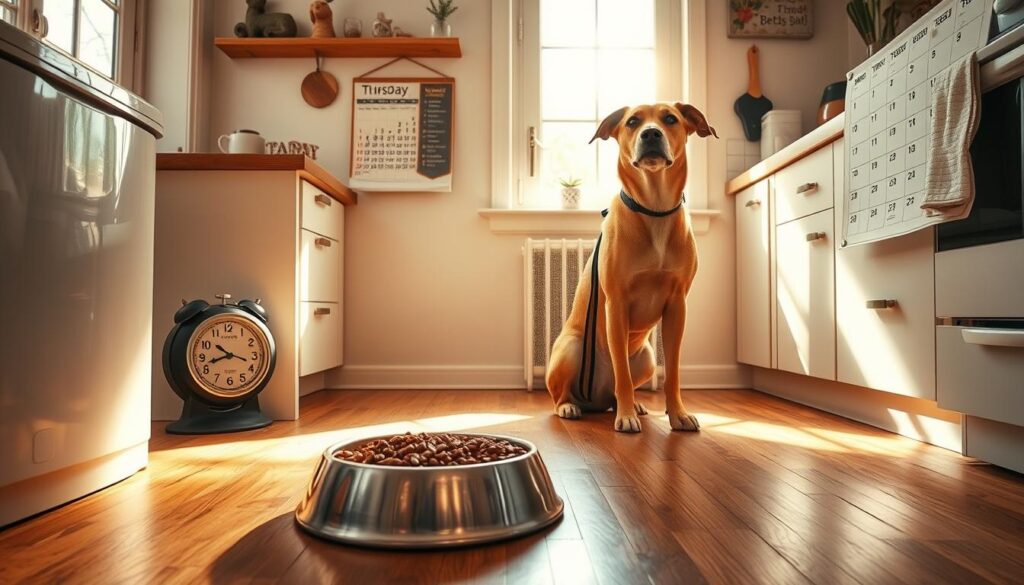
Having a regular meal time is important for your dog’s digestion. It helps you know when they need to go outside. Puppies should eat two to three times a day to grow well and learn to control their bladder.
As your dog gets older, you can change how often they eat. Adult dogs usually do best with two meals a day. Eating at the same times every day keeps their digestion on track.
This makes it easier to know when they’ll need to go outside. It helps you plan their bathroom breaks better.
To stop them from going to the bathroom at night, take away their water 2.5 hours before bed. This helps avoid accidents without making them thirsty. The goal is to make a routine that fits your dog’s natural needs.
| Age | Feeding Frequency | Water Removal Before Bed |
|---|---|---|
| Puppies (2-6 months) | 3-4 times daily | 2 hours |
| Young Dogs (6-12 months) | 2-3 times daily | 2.5 hours |
| Adult Dogs (1+ years) | 2 times daily | 3 hours |
By sticking to a set food schedule, you help your dog with bladder control. Knowing when they’ll eat and go to the bathroom makes it easier for both of you. It helps create a reliable routine for going to the bathroom.
Using Crate Training for Bladder Control

Crate training is great for helping dogs control their bladders. It makes a safe space for them. It can take a few days to a few weeks to get it right.
Selecting the Right Crate Size
It’s important to pick the right crate size. The crate should let your dog stand, turn, and lie down easily. The right size helps prevent accidents and improves bladder control.
| Dog Size | Crate Dimensions (L x W x H) | Recommended Capacity |
|---|---|---|
| Small (up to 25 lbs) | 24″ x 18″ x 21″ | 22-30 lbs |
| Medium (26-40 lbs) | 30″ x 21″ x 24″ | 31-40 lbs |
| Large (41-70 lbs) | 36″ x 24″ x 27″ | 41-70 lbs |
| Extra Large (71-90 lbs) | 42″ x 28″ x 31″ | 71-90 lbs |
Gradual Duration Increases
Start with short crate times and slowly increase them. Young dogs can hold their bladder for a few hours. The crate time should not be longer than their bladder can handle, which is their age in months plus one hour.
Begin by having your dog eat near the crate. Then, move to having them spend up to 30 minutes quietly in the crate.
Remember, crate training should be positive. Don’t use it as punishment. For longer times, use a playpen or a dog zone. With patience and consistency, your dog will see the crate as a safe space. This will improve their training and bladder control.
Teaching your dog to signal when they need to go

Teaching your dog to signal when they need a bathroom break is key. This communication training can take 6 to 12 months to master. Smaller dogs need more frequent potty breaks because their bladders are smaller.
Begin by using different verbal cues for peeing and pooping. This makes it clear to your dog what you want. Use the capturing training method by adding a verbal cue while your dog is going to the bathroom. This method builds on what your dog already knows, making it easier for them to learn.
Consistency is crucial in potty signal training. Link the verbal cue with the action and reward your dog within 1.6 seconds. This quick reward helps your dog connect the action with the reward. Practice the potty cue in different places to make the skill more general.
Think about using door bells as a potty signal. Train your dog to ring the bells when they need to go out. This clear signal helps avoid accidents and improves your communication.
| Potty Training Tips | Benefits |
|---|---|
| Use different verbal cues for peeing and pooping | Clearer communication |
| Implement capturing training method | Builds on existing behavior |
| Reward within 1.6 seconds | Strengthens behavior-reward correlation |
| Practice in various locations | Generalizes the skill |
| Use door bells as potty signals | Provides clear communication |
Recognizing Medical Issues Affecting Bladder Control
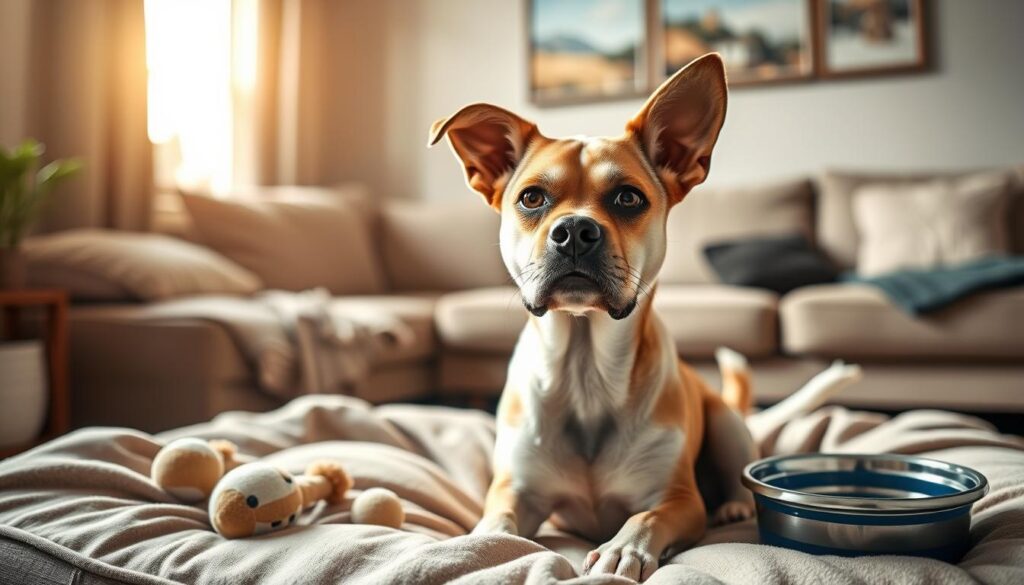
Medical conditions can really affect your dog’s bladder control. Issues like urinary tract infections, bladder stones, and incontinence can change how your pet goes to the bathroom.
Urinary tract infections make dogs pee a lot and hurt. If your dog struggles to pee or has blood in their urine, it’s time to see a vet. Bladder stones can cause the same problems, so getting a vet’s help is key.
Incontinence is common in older or spayed female dogs. It makes them pee without meaning to. This happens in up to 20% of spayed females and 30% of big breeds. Hormonal imbalances, weak muscles, or brain problems can cause it.
Other issues that might mess with bladder control include:
- Kidney disease
- Diabetes
- Prostate problems in male dogs
- Brain issues in older pets
If your dog’s bathroom habits change, see a vet. They can do tests like urinalysis, blood work, or ultrasounds to find out why. Catching and treating problems early can help your dog feel better.
Teaching your dog to control their bladder is important. But first, you need to address any medical issues. With the right care, many dogs with bladder problems can live happy, healthy lives.
Remember, training your dog for better bladder control is important, but addressing medical issues should always be the first step. With proper care and management, many dogs with bladder control problems can lead happy, comfortable lives.
Environmental Factors That Impact Bladder Training

When training your dog to hold their bladder longer, it’s crucial to consider environmental factors. The indoor climate and outdoor access play significant roles in your dog’s potty habits. I’ll share insights on how these elements affect bladder training and offer tips for an effective potty area setup.
Indoor Temperature Considerations
The indoor climate can influence your dog’s need to urinate. Extreme temperatures may cause your pet to drink more water, leading to more frequent bathroom breaks. Maintain a comfortable room temperature to help regulate your dog’s water intake and bladder control.
Exercise Area Accessibility
Easy outdoor access is important for successful bladder training. A convenient potty area encourages your dog to hold it until they reach the designated spot. If outdoor access is limited, consider indoor potty solutions like grass patches. This setup can be especially helpful for apartment dwellers or during harsh weather conditions.
| Environmental Factor | Impact on Bladder Training | Solution |
|---|---|---|
| Indoor Temperature | Affects water intake and urination frequency | Maintain consistent, comfortable room temperature |
| Outdoor Access | Influences ability to reach potty area | Provide easy access or use indoor potty solutions |
| Potty Area Cleanliness | Affects willingness to use designated area | Keep potty area clean and inviting |
Remember, a clean and inviting potty area is essential for consistent use. Regular maintenance of your dog’s bathroom spot, whether indoors or outdoors, encourages proper elimination habits and supports your bladder training efforts.
Common Mistakes to Avoid During Training

Training your dog to hold their bladder longer can be tough. Many pet owners make mistakes that slow them down. I’ll share tips on avoiding these errors and using positive methods for success.
Punishment Prevention
Punishing your dog for accidents is a big mistake. It makes them anxious and hinders learning. Instead, use positive reinforcement techniques to encourage good behavior. Reward your pup when they go potty in the right spot.
Inconsistency Issues
Consistency is crucial in bladder training. Everyone in the family must follow the same rules and routines. Create a schedule for potty breaks and stick to it. This helps your dog know when it’s time to go out.
Unrealistic Expectations
Patience is instrumental in training because you cannot expect your dog to be perfect right away. Puppies under 12 weeks need potty breaks every 1-2 hours. Most dogs master bladder control by 9-12 months. Set goals that match your dog’s age and needs.
| Training Mistake | Impact | Solution |
|---|---|---|
| Punishment for accidents | Creates anxiety, slows progress | Use positive reinforcement |
| Inconsistent routines | Confuses the dog | Establish a consistent schedule |
| Rushing the process | Leads to frustration | Be patient, set realistic goals |
By avoiding these common mistakes and using positive training methods, you’ll help your dog succeed in bladder control. Remember, every dog learns at their own pace. Stay patient and consistent throughout the process.
Managing Nighttime Bladder Control

Teaching your dog to use the bathroom at night is vital for a good sleep. Start by slowly increasing the time between potty breaks as your dog grows. Puppies usually can hold their bladder for as many months as they are old. So, a 3-month-old puppy might need to go every 3-4 hours, and a 4-month-old can wait 4-5 hours.
To help your dog sleep better, limit their water before bed. Take them out right before you go to sleep and again in the morning. Young puppies might need to go out at night. Make these trips quick to avoid playtime.
Being consistent is important for your dog’s nighttime habits. Here are some tips for their sleep schedule:
- Feed the last meal 2-3 hours before bedtime
- Establish a routine for the final potty call just before bed
- Gradually shift feeding times by 15 minutes each day until reaching the desired schedule
- For puppies under 4-6 months, plan for nighttime breaks
Dogs learn quickly, especially within 3-5 seconds. Use this to your advantage during training. With patience and consistency, your dog will learn to control their bladder at night. This will help both of you sleep better.
Exercise and Physical Activity Impact

An effective exercise routine is important for your dog’s digestive and bladder health. Regular physical activity keeps them active and can change how often they need to go potty. Daily walks and playtime boost health and help with bladder training.
More activity means more potty breaks. Adjust your dog’s potty schedule to match their activity level. For example, after a long walk or intense play, they might need to go sooner.
| Activity Level | Estimated Potty Frequency | Recommended Exercise Duration |
|---|---|---|
| Low | Every 4-6 hours | 30 minutes daily |
| Moderate | Every 3-4 hours | 45-60 minutes daily |
| High | Every 2-3 hours | 60-90 minutes daily |
These are general guidelines. Your dog’s needs can vary by age, breed, and health. Watch your dog’s behavior and adjust their exercise to improve bladder control and stay active.
Dietary Considerations for Better Bladder Control

Dog nutrition is vital for bladder control because the right food and feeding schedule can greatly improve your dog’s health. This includes their digestive and urinary habits.
Food Types and Their Effects
The food you choose affects your dog’s bladder. It’s important to pick high-quality food that fits your dog’s age and size. Foods that help with hydration and digestive health are good choices.
| Food Type | Effect on Bladder Control |
|---|---|
| High moisture content | Supports bladder health |
| Chicken, pork, beef, eggs | Promotes acidic bladder environment |
| Broccoli, carrot, sweet potato | May increase urination frequency |
Meal Timing Strategies
Timing your dog’s meals can help with digestion and elimination. Feeding two to three meals a day can improve their digestive health. Here are some tips:
- Feed smaller, more frequent portions
- Avoid feeding close to bedtime
- Monitor water intake, especially in the evening
Adult dogs need less than 350 calories per cup of food. To find your dog’s daily calories, use this formula: 30 x weight in kg + 70. This helps keep your dog at a healthy weight, which is important for bladder control.
Every dog is different. Some breeds need more or less of certain nutrients. Working dogs might need different food than house dogs. Always talk to your vet to find the best diet for your dog’s bladder health.
Special Considerations for Senior Dogs
As dogs get older, they often have trouble controlling their bladders. Training senior dogs to use the bathroom outside needs patience and understanding. Elderly dog care includes dealing with incontinence, which affects 11-20% of spayed female large breeds.
Older dogs may also have trouble moving because of joint pain. This makes it hard for them to go outside to the bathroom. Dementia in senior dogs can cause them to forget to go outside, leading to accidents inside.
To help, we should take them outside more often, 4-6 times a day. Watching for signs like pacing, circling, or whining helps us know when they need to go. Online dog training resources offer great advice for handling senior dog behaviors.
Medical problems can also cause incontinence in older dogs. Issues like urinary tract infections, chronic kidney disease, and hormonal imbalances can affect bladder control. It’s important to take them to the vet to check for these problems.
The vet might suggest blood tests or other tests to find the cause. With the right care, we can help our senior dogs stay comfortable and dignified in their later years.
